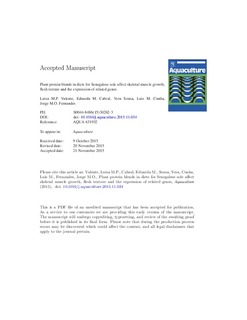| dc.contributor.author | Valente, Luisa M.P. | |
| dc.contributor.author | Cabral, Eduarda M. | |
| dc.contributor.author | Sousa, Vera | |
| dc.contributor.author | Cunha, Luis M. | |
| dc.contributor.author | Fernandes, Jorge M.O. | |
| dc.date.accessioned | 2016-01-29T07:15:14Z | |
| dc.date.accessioned | 2016-02-01T09:34:05Z | |
| dc.date.available | 2016-01-29T07:15:14Z | |
| dc.date.available | 2016-02-01T09:34:05Z | |
| dc.date.issued | 2015 | |
| dc.identifier.citation | Valente, L.M.P., Cabral, E.M., Sousa, V., Cunha, L.M. & Fernandes, J.M.O. (2015). Plant protein blends in diets for Senegalese sole affect skeletal muscle growth, flesh texture and the expression of related genes. Aquaculture, 453, 77-85. doi: | nb_NO |
| dc.identifier.issn | 0044-8486 | |
| dc.identifier.uri | http://hdl.handle.net/11250/2375455 | |
| dc.description | Author's accepted version (postprint). | nb_NO |
| dc.description | Available from 26/11/2017. | |
| dc.description.abstract | Skeletal muscle growth and flesh quality of Senegalese sole fed diets containing increasing levels of plant protein blends to replace fishmeal were evaluated using muscle cellularity, texture profile and gene expression. A control fish meal-based diet (FM) was compared with three isonitrogenous (54%) and isolipidic (9%) diets with increasing levels of plant protein (PP) blends (50% PP50, 75% PP75 and 100% PP100). By the end of the experiment sole fed PP50 and PP75 had a final body length similar to the CTR (25 cm), but fish fed PP100 were significantly smaller (23 cm). Total FM replacement by PP sources resulted in significantly smaller muscle cross sectional area (CSA) mainly due to a decrease in the muscle fibre size as the total number of fibres did not vary significantly among treatments. The dietary incorporation of PP significantly reduced the expression of several key genes involved in myogenesis and muscle growth (mrf4, fgf6, myhc and mylc2). Fillet texture analysed instrumentally was affected by the total substitution of FM. Fish fed PP100 diet had a significantly higher modulus of elasticity, i.e. lower flesh stiffness, compared with the other groups. Muscle fibre size was moderately related (r = − 0.573) to the modulus of elasticity and positively correlated with the expression of lysyl oxidase (r = 0.495). The observed changes in muscle cellularity could not be associated with the expression of texture-related genes (capn2, ctsb, ctsd), since no significant differences were observed among diets. The present results point towards a modulation of the expression of several muscle growth related genes by increasing levels of PP sources that alter muscle cellularity and textural properties of Senegalese sole when total FM is replaced by PP. | nb_NO |
| dc.language.iso | eng | nb_NO |
| dc.publisher | Elsevier | nb_NO |
| dc.rights | Navngivelse-Ikkekommersiell-IngenBearbeidelse 3.0 Norge | |
| dc.rights.uri | http://creativecommons.org/licenses/by-nc-nd/3.0/no/ | |
| dc.title | Plant protein blends in diets for Senegalese sole affect skeletal muscle growth, flesh texture and the expression of related genes | nb_NO |
| dc.type | Journal article | nb_NO |
| dc.type | Peer reviewed | nb_NO |
| dc.date.updated | 2016-01-29T07:15:14Z | |
| dc.subject.nsi | VDP::Agriculture and fishery disciplines: 900::Fisheries science: 920::Aquaculture: 922 | nb_NO |
| dc.subject.nsi | VDP::Mathematics and natural science: 400::Basic biosciences: 470::Genetics and genomics: 474 | nb_NO |
| dc.source.pagenumber | 77-85 | nb_NO |
| dc.source.volume | 453 | nb_NO |
| dc.source.journal | Aquaculture | nb_NO |
| dc.identifier.doi | 10.1016/j.aquaculture.2015.11.034 | |
| dc.identifier.cristin | 1295534 | |

